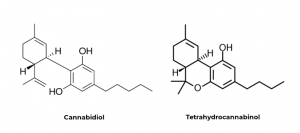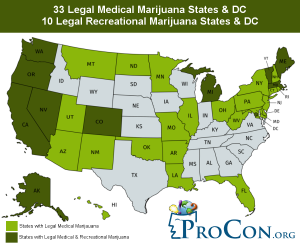Marijuana is found in many cultures around the world. People in India used it in ancient times for its medicinal properties. The Rastafari religion in Jamaica promotes cannabis for religious uses. In the United States it has been used illegally for recreational purposes for years and now it is being used at an increasing rate as a medical treatment to some health problems. What is going on in marijuana?
CBD vs. THC
The two main active chemicals in marijuana are Cannabidiol (CBD) and Tetrahydrocannabinol (THC). They are nearly identical to each other in chemical structure with each having 21 carbons, 30 hydrogens, and 2 oxygens. As you can see in the picture below, the only difference is how an oxygen is bound. So if they are so similar in structure, shouldn’t they do the same things?
https://medium.com/cbd-origin/cbd-vs-thc-the-difference-explained-b3cfc1da52f0
That answer is no. These two molecules are different in the ways that they bind to Cannabinoid Receptors. There are two different types of Cannabinoid Receptors: CB1 and CB2. CB1 is primarily found in the brain and in the central nervous system whereas CB2 is mostly found in peripheral organs and the immune system. CBD and THC both bind to the CB2 receptor enabling them to make changes to the immune system and these peripheral organs. But, THC binds to CB1 in the brain causing psychoactive effects like “getting high”. CBD does not bind to CB1 and can actually negate the bond between CB1 and THC, neutralizing the psychoactive effects.
So many companies and states have started using CBD oil as a beneficial product to help boost the immune system of individuals. This also keeps large concentrations of THC out of the brains of these people. That being said, medical marijuana with both THC and CBD are still in use.
Medical Usage states
Medical marijuana has been legalized in 33 States and recreational marijuana has been legalized in 10 states, below is a map of these “green states”. Marijuana has been used to treat migraines, anxiety, cancer, obesity, and general pain.

https://medicalmarijuana.procon.org/view.resource.php?resourceID=000881
Reasons for Hesitation
So if using marijuana as a medical drug can be so helpful to our society, what makes people not want this to happen everywhere?
THC that binds to the CB1 receptors in the brain causes psychoactive effects. One part of the brain that these receptors are very prevalent in is the hippocampus, the hub for memory. With chronic use of marijuana, there is a possibility for long-term effects on the memories of those using.
Another reason is the lack of parameters to police usage. With alcohol, we have a clear limit of how much can be in your blood before you are impaired to drive. With THC it is harder to test, and THC can stay in the body for much longer making the test less accurate.
Conclusion
As I am writing this blog, marijuana is still classified as a Schedule I drug by federal law. This makes it very difficult to obtain marijuana to do research to find scientific evidence of more uses of marijuana. Many people think that we could more easily find a middle ground for marijuana if it were lowered to a Schedule II or Schedule III drug. Along with this we could do more research to possibly make it even better as a medicine and potentially less dangerous.